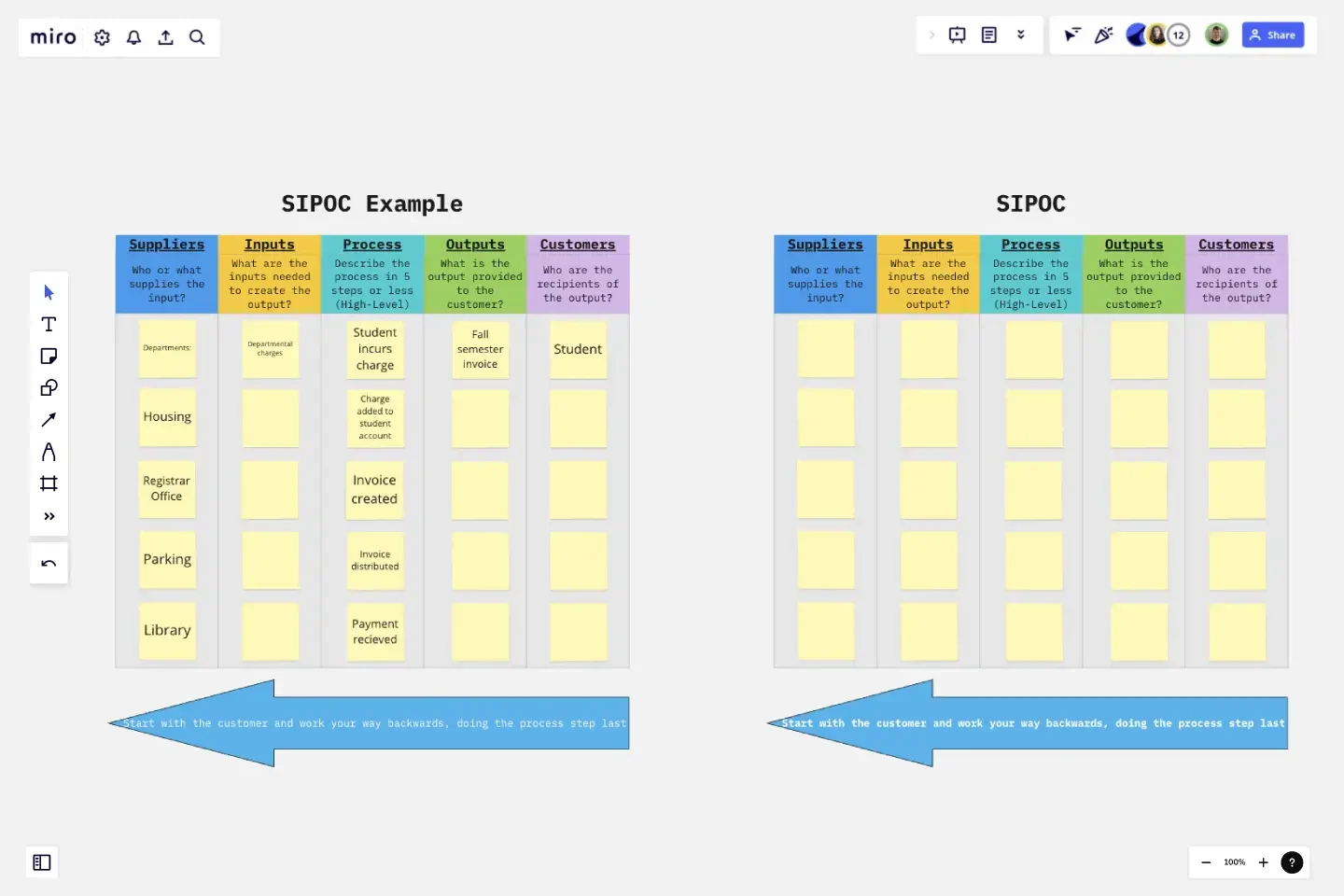SIPOC
The SIPOC Template can be used as the first step in understanding the process being evaluated.
The SIPOC Template can be used as the first step in understanding the process being evaluated. This template is designed to be utilized as a brainstorming tool during the project documentation stage with a team to identify customers and suppliers (stakeholders).
How to use the SIPOC Template:
(Start with the Customers and work backwards)
Step 1: Customers
Brainstorm with the team to identify the customers who receive the output the process creates.
Step 2: Outputs
Articulate the outputs of the process that gets delivered to the customer.
Step 3: Inputs
Document the inputs that are needed to create the output.
Step 4: Suppliers
Identify who or what supplies the input required to create the output.
Step 5: Process
Describe the high-level steps that make up the process in 5 steps or less.
This template is a collaborative effort
Utilizing an approach of collaboration, Dagmar Vlahos and Thomas Lencki Jr. lead employees through their Lean journey. They support all employees at all of the campuses in University System of New Hampshire through training, mentorship, and coaching. Using this approach Dagmar and Tom created this template together.
#Lean all day, every day!
Get started with this template right now.
What? So What? Now What? Template
Works best for:
Agile Workflows, Retrospectives, Brainstorming
The What? So What? Now What? Framework empowers you to uncover gaps in your understanding and learn from others’ perspectives. You can use the What? So What? Now What? Template to guide yourself or a group through a reflection exercise. Begin by thinking of a specific event or situation. During each phase, ask guiding questions to help participants reflect on their thoughts and experience. Working with your team, you can then utilize the template to record your ideas and to guide the experience.
Iceberg Reflection
Works best for:
Agile
The Iceberg Reflection template is a visual tool for facilitating reflective exercises within Agile teams. It prompts participants to explore both visible and underlying aspects of challenges or successes, akin to an iceberg where only a portion is visible above the waterline. This template encourages deeper reflection and insights, fostering a culture of continuous improvement and learning. By addressing root causes and hidden factors, teams can better understand and overcome obstacles, driving growth and resilience.
Penny Game
Works best for:
Agile
The Penny Game is a simulation exercise that illustrates the impact of batch size and work in progress on cycle time and throughput. By tracking the flow of pennies through a production system, teams learn how to identify bottlenecks, optimize processes, and improve efficiency. This template offers a practical way to explore Lean principles and drive continuous improvement, empowering teams to streamline their workflow and deliver value more predictably.
Taco Tuesday Retrospective
Works best for:
Agile Methodology, Retrospectives, Meetings
The Taco Tuesday Retrospective template offers a fun and informal approach to retrospectives, perfect for fostering team camaraderie. It provides elements for reflecting on past iterations over a casual taco-themed gathering. This template enables teams to relax, share insights, and brainstorm ideas in a laid-back atmosphere. By promoting social interaction and creativity, the Taco Tuesday Retrospective empowers teams to strengthen relationships, boost morale, and drive continuous improvement effectively.
5Gs Retrospective
Works best for:
Agile Methodology, Retrospectives, Meetings
The 5Gs Retrospective template offers a structured approach for teams to reflect on their projects or iterations, focusing on five key aspects: Goals, Gains, Gratitude, Gaps, and Growth. It provides elements for identifying achievements, expressing gratitude, and addressing areas for improvement. This template enables teams to conduct retrospectives systematically, fostering a culture of learning, appreciation, and continuous improvement. By emphasizing the five dimensions of reflection, the 5Gs Retrospective empowers teams to optimize their performance, enhance collaboration, and achieve their goals effectively.
Work Plan Template
Works best for:
Mapping, Project Planning
A work plan is essentially a roadmap for a project. It articulates the steps you must take to achieve the desired goal, sets demonstrable objectives, and establishes measurable deliverables. An effective work plan guides you throughout the project lifecycle, allowing you to realize an outcome by collaborating with your team. Although work plans vary, they generally contain four core components: goals, strategy, tactics, and deliverables.
